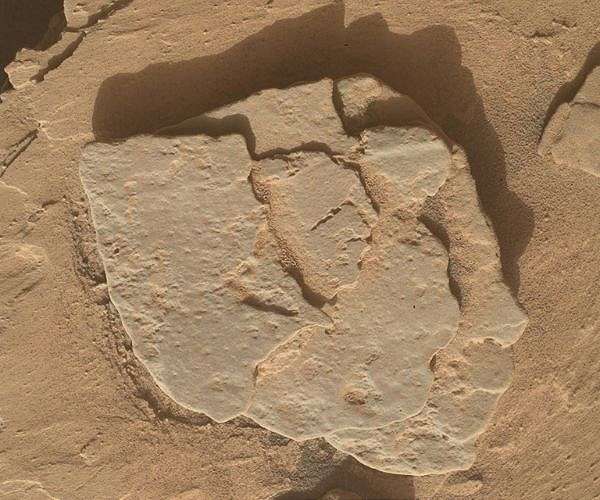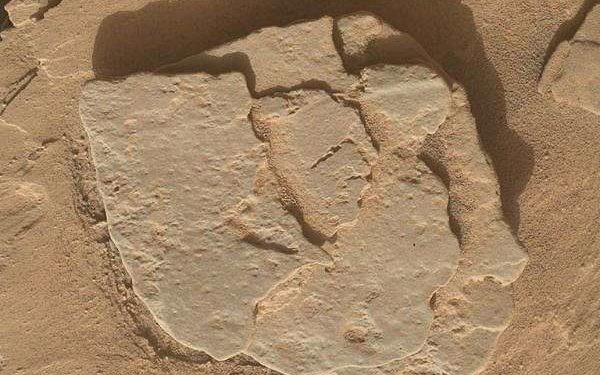
Double DRT for a Soliday: Sols 3964-3965:
by Natalie Moore | Mission Ops – MSSS
Pasadena CA (JPL) Sep 29, 2023
Earth planning date: Friday, September 29, 2023: Welcome to another weekend in Gale crater, Mars! As Abigail Knight described in Wednesday’s blog, we elected not to drive last plan while we waited for the workspace imaging from Navcam and Mastcam to arrive on Earth. All went as expected and we received the necessary imaging to assess the terrain well enough for using our DRT on the beautiful light-toned slab of rock in front of us.
With that image open, I just want to point out our remote and contact science targets we analyzed from Wednesday: The sol 3962 ChemCam LIBS target, Pants Pass, was in the mid-right region of the slab with the sedimentary layers. Here you can see the LIBS spots on the Pants Pass layers from the ChemCam RMI. The contact science targets, Blackcap Mountain and Burnt Mountain, are the dark-toned raised layers on the lower-middle and upper-middle of the slab respectively (you can’t miss em!).
It’s critical to characterize the bedrock between the light-toned blocks and the dark-toned blocks up ahead, so for today’s plan we decided on two (!) DRT targets to double up the contact science while we’re in a stable position to unstow the arm. The first DRT target, “Cloudripper,” is located on a super flat spot to the left of Blackcap Mountain.
The Second DRT target, “White Pass,” is located on another flat spot below Burnt Mountain and above Pants Pass. MAHLI will go down to ~3cm distance from each of those targets for a full suite of images, which means we can get ~0.017 mm/pixel resolution – the grain size of siltstone!
For remote science, ChemCam is shooting their LIBS on Wednesday’s Burnt Mountain contact science target and a nearby block named “Sky Pilot” (vertically-layered block in the lower-center of this Navcam image). We’re staying at this location for further bedrock analysis on Monday’s plan, so Mastcam will document the LIBS targets from today but defer any mosaics until Monday.
In other news, we have a soliday this weekend (I think I explained this term pretty well in one of my blogs last year) so next week we’ll be able to plan in “unrestricted” sols, which are days where the Earth and Mars time zones align. During unrestricted planning periods, we get information about how the activities we planned on one Earth day actually executed on Mars in time for the start of planning the next Earth day. T
his will be our first unrestricted planning cycle without sufficient budget for Tuesday ops, so we’ll still need to plan two sols at a time on Monday. However, we can save the drive for sol two and keep our APXS evening integrations on the first sol. Hope you have a great soliday weekend!
Full Caption
NASA’s Mars rover Curiosity acquired this image using its Mars Hand Lens Imager (MAHLI), located on the turret at the end of the rover’s robotic arm, on September 29, 2023, Sol 3962 of the Mars Science Laboratory Mission, at 04:02:22 UTC.
When this image was obtained, the focus motor count position was 13017. This number indicates the internal position of the MAHLI lens at the time the image was acquired. This count also tells whether the dust cover was open or closed. Values between 0 and 6000 mean the dust cover was closed; values between 12500 and 16000 occur when the cover is open. For close-up images, the motor count can in some cases be used to estimate the distance between the MAHLI lens and target.
For example, in-focus images obtained with the dust cover open for which the lens was 2.5 cm from the target have a motor count near 15270. If the lens is 5 cm from the target, the motor count is near 14360; if 7 cm, 13980; 10 cm, 13635; 15 cm, 13325; 20 cm, 13155; 25 cm, 13050; 30 cm, 12970. These correspond to image scales, in micrometers per pixel, of about 16, 25, 32, 42, 60, 77, 95, and 113.
Most images acquired by MAHLI in daylight use the sun as an illumination source. However, in some cases, MAHLI’s two groups of white light LEDs and one group of longwave ultraviolet (UV) LEDs might be used to illuminate targets. When Curiosity acquired this image, the group 1 white light LEDs were off, the group 2 white light LEDs were off, and the ultraviolet (UV) LEDS were off.
Related Links
Curiosity Mars Science Laboratory
Mars News and Information at MarsDaily.com
Lunar Dreams and more
